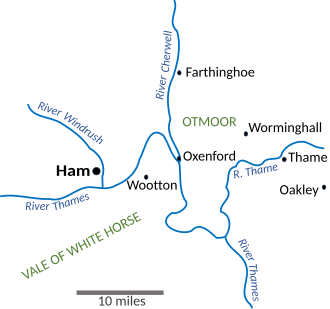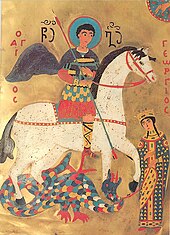Farmer Giles of Ham
 First edition cover | |
| Author | J. R. R. Tolkien |
|---|---|
| Illustrator | Pauline Baynes |
| Cover artist | Pauline Baynes |
| Language | English |
| Genre | Children's literature Fantasy fiction |
| Publisher | George Allen & Unwin |
Publication date | 20 October 1949[1] |
| Publication place | United Kingdom |
| Media type | Print (hardback & paperback) |
| ISBN | 978-0-04-823068-3 |
| Preceded by | "On Fairy-Stories" |
| Followed by | The Homecoming of Beorhtnoth Beorhthelm's Son |
Farmer Giles of Hamis a comicmedieval fable written by J. R. R. Tolkienin 1937 and published in 1949. The story describes the encounters between Farmer Giles and a wilydragonnamed Chrysophylax, and how Giles manages to use these to rise from humble beginnings to rival the king of the land. It is cheerfullyanachronisticand light-hearted, set in Britain in an imaginary period of theDark Ages.It features mythical creatures, medieval knights, and primitive firearms.
Scholars have noted that despite the story's light-hearted nature, reflected in Tolkien's playful use of his professional discipline,philology,it embodies several serious concerns. The setting is quasi-realistic, being the area aroundOxfordwhere Tolkien lived and worked. The story parodies multiple aspects of traditional dragon-slaying tales, and has roots in modern and medieval literature, from Norse myth toSpenser'sThe Faerie Queene.Its concern for the "Little Kingdom" embodiesTolkien's environmentalism,in particular his well-founded fears for the loss of the countryside ofOxfordshireand surrounding areas.
Plot summary
[edit]Farmer Giles (Ægidius Ahenobarbus Julius Agricola de Hammo,"Giles Redbeard Julius, Farmer of Ham" ) is fat and red-bearded and enjoys a slow, comfortable life. A rather deaf and short-sightedgiantblunders on to his land, and Giles manages to send him away with ablunderbussshot. The people of the village cheer: Farmer Giles has become a hero. His reputation spreads across the kingdom, and he is rewarded by the King with an unfashionable old sword.
The giant, on returning home, relates to his friends that there are no more knights in the Middle Kingdom, just stinging flies—actually the scrap metal shot from the blunderbuss—and this entices a dragon fromVenedotia,Chrysophylax Dives, to investigate the area. The terrified neighbours all expect the accidental hero Farmer Giles to deal with him.
The knights sent by the King to pursue the dragon turn out to be full of excuses not to do their duty. The villagers look to Giles to do something. The local priest finds that the old sword is Caudimordax ( "Tailbiter" ), meant specifically for killing dragons.
Giles sets out and meets Chrysophylax. The sword turns out to be able to fight almost on its own; Giles hits the dragon with the sword, damaging its wing so it cannot fly, and leads it through the town. It is made to promise to bring its treasure to the villagers, but it does not keep its word.
The king sends Giles and the knights to deal with Chrysophylax. The knights have never seen any dragon apart from their Christmas dragon-tail cake made ofmarzipan.Chrysophylax kills them. Giles survives, and with his sword he masters the dragon and obtains part of the treasure. On his way home, he acquires the servants of the dead knights. Back at home, with servants and treasure, Giles becomes a powerful lord.
Publication history
[edit]Farmer Giles of Hamwas originally illustrated byPauline Baynes.The story has appeared with other works by Tolkien in omnibus editions, includingThe Tolkien Reader[2]andTales from the Perilous Realm.[3]
Tolkien dedicatedFarmer Giles of Hamto Cyril Hackett Wilkinson (1888–1960), a don (lecturer) he knew atOxford University;Wilkinson had encouraged Tolkien to go ahead with writing the story for the Lovelace Society atWorcester College.[4][5]
Analysis
[edit]Quasi-realistic geographical setting
[edit]
Tolkien, aphilologist,sprinkled philological jokes into the tale, including intentionally falseetymologies.The place-names are of places close toOx[en]fordincludingOakley,Otmoorand theRollright Stones.[6]At the end of the story, Giles is made Lord ofTame,and Count ofWorminghall.The Tolkien scholarJohn Garthcomments that the tale is "an elaborate false explanation for the name of the Buckinghamshire village of Worminghall".[7]
| Worminghall in the story | Worminghall,Buckinghamshire |
|---|---|
| "The hall of the Wormings", people descended from a man who tamed aworm(a dragon) |
"Field of a man named Wyrma" |
Quasi-realistic historical setting
[edit]It has been suggested that the Middle Kingdom is based on earlyMercia,[8]and that Giles's break-away realm (the Little Kingdom) is based onFrithuwald's Surrey.[9]
The tale's Foreword states that the tale is "a translation" from "insular Latin" of events taking place "after the days ofKing Coelmaybe, but beforeArthuror theSeven Kingdoms of the English".[10]
Blunderbuss philology
[edit]
Another joke puts a question concerning the definition of blunderbuss to "the four wise clerks of Oxenford":"A short gun with a large bore firing many balls or slugs, and capable of doing execution [killing people] within a limited range without exact aim. (Now superseded, in civilised countries, by other firearms.) "[11]Tolkien had worked on theOxford English Dictionary,and the "four wise clerks" are "undoubtedly" the four lexicographersHenry Bradley,William Craigie,James Murray,andCharles Talbut Onions.[12]Tolkien then satirises the dictionary definition by applying it to Farmer Giles's weapon:[13]
However, Farmer Giles's blunderbuss had a wide mouth that opened like a horn, and it did not fire balls or slugs, but anything that he could spare to stuff in. And it did not do execution, because he seldom loaded it, and never let it off. The sight of it was usually enough for his purpose. And this country was not yet civilised, for the blunderbuss was not superseded: it was indeed the only kind of gun that there was, and rare at that.[11]
The Tolkien scholarTom Shippeycomments: "Giles's blunderbuss... defies the definition and works just the same."[13]
Parody dragon-slaying tale
[edit]
Romuald Lakowski describesFarmer Giles of Hamas a "delightful, and even in places brilliant, parody of the traditional dragon-slaying tale."[14]The parody has many strands. The hero is a farmer, not a knight; the dragon is a coward, and is not killed, but tamed and forced to return his treasure.[14]Lakowski derives Chrysophylax both from medieval dragons and from comic stories contemporary with Tolkien, likeEdith Nesbit'sThe Dragon TamersandKenneth Grahame'sThe Reluctant Dragon.[14]The story embodies a charter myth, in which Giles's descendants have a dragon on their crest because of his deeds. Further, it serves as a local legend, with mock etymologies of actual place-names.[14] Giles's cowardly talking dog Garm is named forthe terrifying dog of the Norse underworld.[14][15]Giles's magic named sword may derive partly from Norse myth, too; the godFreyrhad a sword that could fight by itself. As for the fight with the dragon, the wounding of the monster's wing echoes an episode inSpenser'sThe Faerie Queene.Other allusions may include the legend ofSaint George and the Dragon,as that dragon was brought back to the city, tamed, and led with the girdle of a maiden round its neck; and theVölsunga saga,as the dragon's cave sounds much likeFáfnir's.[14]
Environmentalism
[edit]Alex Lewis, inMallorn,writes that Tolkien lamented the loss of the countryside in and aroundOxfordshire,which formed "the Little Kingdom" of the story. Tolkien loved nature,especially trees,and had what Lewis calls "well-founded" fears for the environment, "verg[ing] on the prophetic".[16]Lewis analyses the factors that were causing this loss. They included the growth in Oxfordshire's population in the 20th century (doubling between 1920 and 1960); the area'sindustrialisationbyMorris Motors,and the concomitant increase in motor traffic in the city of Oxford; the building of roads, including theM40 motorwaycutting across the countryside; and thesuburbanisationof Oxford ascommutersstarted to use the railway to allow them to live in Oxford but work in London. TheSecond World Warincreased the number of airfields in the area from 5 to 96, causing the Oxfordshire countryside to be "gutted".[16]Lewis states that Tolkien had hoped to write a sequel toFarmer Giles of Ham,but found thathis legendariumhad "bubbled up, infiltrated, and probably spoiled everything", and that it was "difficult [in 1949] to recapture the spirit of the former days, when we used to beat the bounds of the L[ittle] K[ingdom] in an ancient car."[16]Tolkien was horrified by the change that motor traffic wreaked on Oxford, and the air pollution; he had given up his happy but dangerous driving, as depicted in his children's storyMr. Bliss,at the start of the war.[16]
References
[edit]- ^Hammond & Scull 2006a,p. 353.
- ^Tolkien, J. R. R.(1966).The Tolkien Reader.Ballantine.ISBN978-0-3452-4831-2.OCLC26059501.
- ^Tolkien, J. R. R.(2021).Tales from the Perilous Realm.Mariner Books.ISBN978-0-3586-5296-0.
- ^Hammond & Scull 2006b,p. 1102.
- ^Carpenter 2023,Letter 108 to Allen & Unwin, 5 July 1947
- ^Walker, R. C. (1984)."The Little Kingdom: Some Considerations and a Map".Mythlore.10(3). Article 11.
- ^abGarth, John(24 June 2020)."Looking for Middle-Earth? Go to the Middle of England".Literary Hub.Retrieved26 July2023.
- ^Shippey 2005,p. 111 "The capital of the Middle Kingdom, 'some twenty miles distant from Ham', sounds like Tamworth, the historical capital of the Mercian kings".
- ^Reynolds, Patricia (1991). "Frithuwold and the Farmer".Mallorn(28): 7–10.
- ^Tolkien 1949,p. 7.
- ^abTolkien 1949,p. 15.
- ^Hyde, Paul Nolan (1987)."J.R.R. Tolkien: Creative Uses of the Oxford English Dictionary".Mythlore.14(1). Article 4.
- ^abShippey, Tom(1997). "Introduction".Tales from the Perilous Realm.HarperCollins.
- ^abcdefgLakowski, Romuald I. (2015)."'A Wilderness of Dragons': Tolkien's Treatment of Dragons in Roverandom and Farmer Giles of Ham ".Mythlore.34(1). Article 8.
- ^Hargrove, Gene (2013) [2007]."Farmer Giles".InDrout, Michael D. C.(ed.).The J. R. R. Tolkien Encyclopedia.Routledge.pp. 198–199.ISBN978-0-415-96942-0.
- ^abcdLewis, Alex (2003)."The Lost Heart of the Little Kingdom".Mallorn(41): 3–8.
Sources
[edit]- Carpenter, Humphrey,ed. (2023) [1981].The Letters of J. R. R. TolkienRevised and Expanded Edition.New York:Harper Collins.ISBN978-0-35-865298-4.
- Hammond, Wayne G.;Scull, Christina(2006a).The J.R.R. Tolkien Companion and Guide: Chronology.London:HarperCollins.ISBN0-261-10381-4.
- Hammond, Wayne G.;Scull, Christina(2006b).The J.R.R. Tolkien Companion and Guide: Reader's Guide.London:HarperCollins.ISBN0-007-14918-2.
- Shippey, Tom(2005) [1982].The Road to Middle-Earth(Third ed.).HarperCollins.ISBN978-0261102750.
- Tolkien, J. R. R.(1949).Farmer Giles of Ham.George Allen and Unwin.ISBN978-0-04-823068-3.

